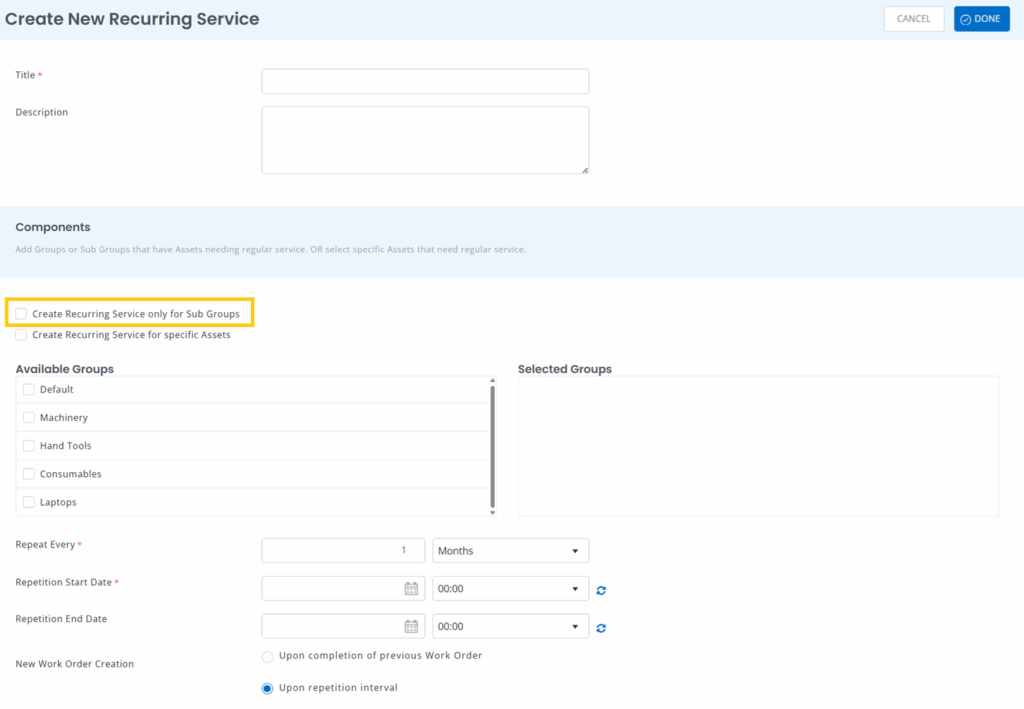This blog explains how to use the Advanced Services and Maintenance feature in EZO using features like Recurring Services and Service Triage. You can use these features to add value to the basic Services and Maintenance workflow.
Related blog: To learn more about using the basic functionality, click here.
1. Recurring Services
You can set recurring services on groups and subgroups using EZO, defining how often you want services to repeat, and establishing start and end dates for effortless maintenance management. To enable this feature, go to Settings → Add Ons → Advanced Service and Maintenance, and enable ‘Recurring Services’.
1.1 Creating Recurring Services
Once you enable Recurring Services, go to: More (…) → Recurring Services → Add New Recurring Service
On the recurring service creation page, enter the title, start/end dates, and recurrence interval.
Choose Recurring Service Scope
You can now create recurring services in two ways:
Option 1: Create a Recurring Service for Groups or Subgroups
Use this when you want the recurring maintenance to apply to all items in a Group or Subgroup.
- Select the Group or check Create Recurring Service only for Sub Groups which will display all the available subgroups and then select the relevant Subgroup.

- Define repetition criteria and dates.

Note: If you select Upon completion of previous Work Order in the repetition criteria, you may also select Make the next service visible immediately after the completion of the previous service. This will make the upcoming service details appear as soon as the previous service ends.

- Configure service creation behavior (see Section 1.2).
Example:
Apply a quarterly “Safety Inspection” to all forklifts in the Construction Accessories subgroup.
Option 2: Create Recurring Service for Specific Assets
Use this if maintenance applies only to a set of individual assets, not the entire group. First of all, you need to select the checkbox for Create Recurring Service for Specific Asstets
You will be displayed the option to search and select relevant items. Search the item and then click Add.

- Set recurrence, dates, and service creation behavior exactly as in Option 1.
Example:
Apply “6-Month Engine Check” only to 3 specific excavators, not the entire heavy equipment group.
Note: These two options are mutually exclusive. Selecting one disables the other.All recurring services—whether for groups/subgroups OR specific assets—appear together in the Recurring Services Listing.
1.2 States of Service
When a recurring service is created, components added in it go into the ‘Pending’ state. The state changes to ‘Active’ when the service event is initiated and is marked ‘Completed’ when it ends. These actions must be taken manually by the user.
Pending: In this state, assets associated with the component(s) defined in the recurring service are automatically sent to a Pending Service state.
Active: This means the service has started and the asset is now unavailable.
Completed: Clicking ‘End Service’ will stop recurring service on the groups you have configured under a recurring service.

1.3. Service Actions and Overview
To trigger the ‘Active’ state, you have two options.
1) Asset’s Detail Page → Service → Start Service:

2) Notification Bell → Services → Pending Tab → Start Service.
This section is also a great place to get an overview of service events that are active, scheduled, completed, and pending:

Account Owners and Admins can also enable ‘Service Edit and Deletion’ from Company Settings. Please note that you can only edit the service date and description of an ‘active’ service, whereas a ‘completed’ service can only be deleted. However, if deleted, any linked inventory consumed in that service will be replenished. See image below:

1.4. Recurring Services and Packages
Recurring service will only be applied to those items in a package that are associated with groups or subgroups included in a recurring service. All the items in a package that don’t belong to such groups or subgroups will be sent into ‘regular’ maintenance immediately.
Example: A package contains 2 cameras from Group ‘AV’ and 2 laptops from group ‘IT’. A recurring service has been created with the group ‘AV’ as a component. When the recurring service starts on this group, all the items in the package belonging to ‘AV’ will go into a Pending state for a recurring service, whereas all the items belonging to the group ‘IT’ will be sent into regular maintenance and will be marked as ‘Active’.
Learn More about how to use Packages.
2. Services and Maintenance via import
Go to the Asset listings page → Import → Start Service
Click on Start Service to create service records for your existing records. You will be prompted to upload an excel containing service details for the assets. A sample file can be downloaded from Step 1:
In step 2, verify the details and upload the service details for assets. The following columns will be uploaded:
- Asset #
- Service Type
- Service Performed by
- Service Performed by (Vendor name/email)
- Description
- Expected Completion Date
- Expected Completion Time
- Under service Indefinitely
- Linked Inventory Items
Check all the details entered and proceed to step 3. Any errors will be displayed here and you can proceed to complete the upload.
You can follow the same steps for completing a service, and creating service records. All services added will be displayed on the Asset details page.
3. Service Triage
You can also set your account to automatically send assets into maintenance after an item is checked in. This will ensure that equipment is always in the best state before it is checked out again. To enable this, go to Settings → Add Ons → Service Triage. You can set the service period here. This can either be enabled for all groups or for a specific group from its detail page.
Once done, an asset will automatically be sent into maintenance for the duration specified each time it is checked in. You can also disable Service Triage on a certain group of assets from the group’s details page:

Share your queries on our Services feature
Keep your heavy equipment in optimal working conditions and conduct timely maintenance with our CMMS compliant software. It is the leading equipment management software used by a diverse set of companies worldwide.
For more assistance, drop us an email at support@ezo.io.








